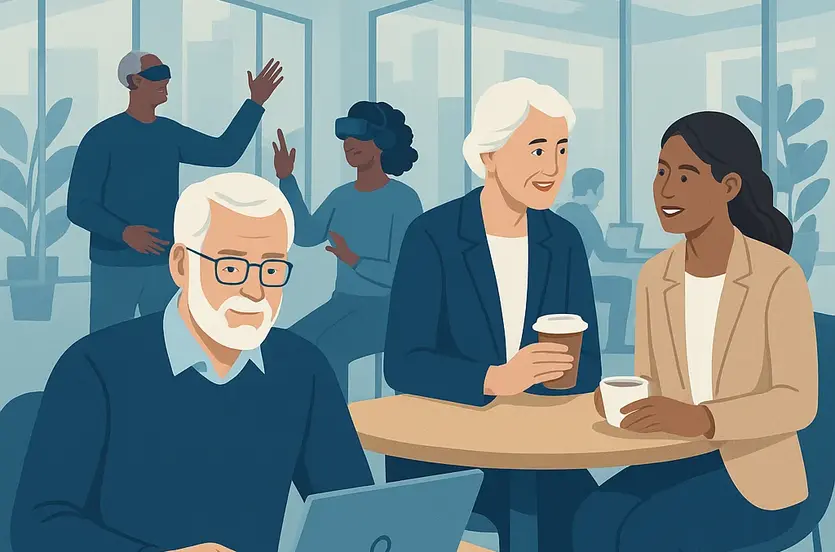Introduction: Retirement, Reinvented
Retirement isn’t what it used to be. For decades, the typical image involved golf courses, gardening, and long, leisurely afternoons. But today, a growing number of people in their 60s and 70s are rewriting that script. Whether driven by financial need, personal fulfillment, or a desire to stay mentally active, older workers are choosing to “unretire”—embracing new roles in consulting, part-time work, and even startups.
This phenomenon is fueling what economists call the “Silver Economy”—an emerging labor and consumer market built around aging populations. In this new chapter, age isn’t a barrier. It’s an asset.
What Is the Silver Economy?
The Silver Economy refers to the economic opportunities created by people aged 50 and above. It covers a broad spectrum—from healthcare, travel, and financial services to employment, education, and digital inclusion.
But beyond consumer spending, the biggest shift is happening in the workplace. According to the World Economic Forum, workers over 60 are now the fastest-growing segment of the global labor market. In countries like the U.S., U.K., Japan, and Germany, retirement rates are flattening while reentry rates are rising.
Why Are Older Workers Returning?
Several key trends are driving this shift:
1. Financial Necessity
- Rising inflation and longer life expectancy mean retirement savings need to stretch further.
- Many pensions and social security schemes no longer fully support modern retirees’ needs.
2. Health & Longevity
- People in their 60s and 70s are more active and healthier than ever.
- This improved quality of life makes continued work possible—and often enjoyable.
3. Psychological Fulfillment
- Retirees often miss the sense of purpose and routine that work provides.
- Jobs offer opportunities for connection, growth, and mental engagement.
4. Post-COVID Realignment
- The pandemic gave many retirees time to rethink priorities and explore remote or flexible roles.
- Digital adoption made reentering the workforce easier from home.
Looking for your encore career?
Explore flexible jobs, consulting gigs, and remote roles on WhatJobs.com — built for professionals of every generation.
Find Your Encore Role →The Rise of the Encore Career
The term “Encore Career” describes a second (or third) career taken on later in life, often with social impact or personal meaning at the core. This may include roles in:
- Nonprofits and education
- Freelance and consulting
- Mentorship or advisory boards
- Small business ownership
These careers are often less stressful but more personally rewarding. According to Encore.org, nearly 9 million Americans aged 50+ are actively pursuing work with purpose.
New Career Paths for the 60+ Workforce
Here are some roles thriving in the silver economy:
1. Independent Consultants
Older professionals with years of expertise in fields like HR, IT, marketing, and operations are increasingly hired as consultants. Companies benefit from experience without full-time overhead.
2. Fractional Executives
Roles such as fractional CFOs, CMOs, or COOs allow seasoned professionals to guide multiple organizations a few days a month—perfect for those who want flexible work with high impact.
3. Gig and Remote Work
The digital workplace is more inclusive than ever. From virtual assistants to customer support and bookkeeping, remote-friendly jobs are ideal for retirees.
4. Tutors, Trainers & Coaches
Education and mentoring are natural fits. Older workers bring a wealth of wisdom and calm that younger professionals value.
5. Entrepreneurship
In the U.S., people over 55 account for nearly 50% of new business founders, according to the Kauffman Foundation. Many are monetizing hobbies, passions, or niche consulting.
Companies Are Catching On
Smart companies recognize that older workers offer:
- Deep industry knowledge
- Emotional intelligence and reliability
- Mentorship for younger staff
- High loyalty and lower attrition
Some large organizations are even creating programs to attract retirees back to work, such as:
- “Returnships”: Like internships, but for retired professionals re-entering the workforce.
- Alumni networks: Offering former employees contract work or short-term projects.
- Flexible work policies: Including part-time, remote, and job-sharing arrangements.
Companies like BMW, Barclays, and Marriott have piloted successful programs focused on experienced talent.
Challenges Facing Older Job Seekers
While opportunity is growing, ageism remains a real barrier. AARP research shows that more than 60% of older workers have seen or experienced age discrimination at work.
Tips to Overcome This:
- Refresh your resume: Focus on skills and outcomes rather than chronology.
- Upskill with digital tools: Courses in Zoom, Slack, or AI tools like ChatGPT can be game-changers.
- Leverage LinkedIn: Build a strong profile and showcase thought leadership.
- Practice your pitch: Emphasize adaptability, experience, and a desire to grow—not just “ride it out.”
The Silver Economy’s Broader Impact
The shift isn’t just benefiting older professionals—it’s influencing the economy in profound ways:
- Workforce Shortages: Countries facing labor shortages (like Japan and Germany) are relying more on older workers to fill gaps.
- Multigenerational Teams: Companies are learning to harness the power of teams that include Gen Z, Millennials, Gen X, and Boomers.
- Longevity Tech: New startups are emerging to help older workers stay healthy, productive, and connected—creating new innovation sectors.
Conclusion: Redefining What’s Next
The Silver Economy is not a trend—it’s a revolution. Older workers aren’t just staying in the workforce longer; they’re shaping it. They’re launching businesses, mentoring future leaders, and proving that wisdom and agility can go hand in hand.
Retirement is no longer the end of a career. For many, it’s just the next beginning.




